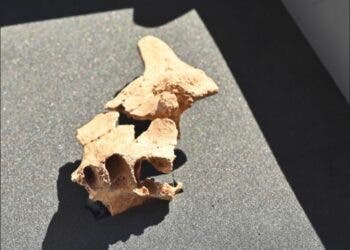
A recent study in Geology proposed that a slow and steady process grew the meter-sized gypsum crystals inside the giant geode of Pulpí. Temperature fluctuations from thousands of years ago ripened the crystals and made them literally crystal clear.
“Giant crystals are scarce,” said coauthor Juan Manuel García-Ruiz, a professor at the Universidad de Granada in Spain. The Pulpí geode is “an ovoid, an egg-shape cavity in the rock lined with crystals. But its size is 11 cubic meters, the largest [geode] in the world.”
Rare in Size and Clarity
The Pulpí geode was discovered in 1999 in Mina Rica, a former silver mine in Almería, Spain. Its gypsum crystals are up to 2 meters in size and are so clear and pure you can see the rock behind them.

It’s taken a while to figure out the geode’s origins because “the hydrothermal system in the origin of these crystals was exhausted,” García-Ruiz said. Most areas that have grown giant gypsum crystals are attached to inactive hydrothermal systems, the team wrote, with the exception of the Cave of Crystals in Naica in Mexico.
Without an active hydrothermal system to help unravel the geode’s origin, “we realized that we needed to unveil the geological history of the mine,” he said.
The researchers found that the rock that encompasses the geode is made of layered carbonate from the Triassic period (201–251 million years ago). The geode, however, is only between 60 thousand and 2 million years old.
“The exact [formation] date is still unknown,” García-Ruiz said. “The crystals are so pure that radiometric methods cannot measure their age.”
Low Temperature, Slow Drip
Those large crystals, however, did trap a few fluid inclusions that retained information about conditions at the time the crystals formed. The team measured the sulfur and oxygen isotope ratios of those inclusions and found that the gypsum likely stabilized at a temperature of about 20°C.
That’s much lower than the maximum soluble temperature for gypsum (45°C), which suggests that the crystals grew over a long period of time from a slow, steady drip of a concentrated calcium sulfate solution. With a relatively stable temperature, many smaller gypsum crystals dissolved to form fewer, larger ones in a process called Ostwald ripening.“Temperature fluctuations amplified the mechanism, resulting in these astonishing transparent gypsum crystals.”However, “Ostwald maturation for large crystals has not yet [been] experimentally demonstrated,” said lead author Àngels Canals of the Universitat de Barcelona in Spain. “We propose that temperature fluctuations amplified the mechanism, resulting in these astonishing transparent gypsum crystals.” If the gypsum formed around 20°C, it was likely much closer to the surface than it is today, the team argued, so the temperature fluctuations may have been caused by a shifting climate.
Mike Rogerson, an Earth system scientist at the University of Hull in the United Kingdom who was not involved with the research, told National Geographic that surface temperature changes might not have reached belowground. It’s more likely that the geode’s now inactive geothermal system created the temperature fluctuations, he said. Either way, he was excited to see the team delve into the geologic history of this popular tourist destination.
—Kimberly M. S. Cartier (@AstroKimCartier), Staff Writer
This article originally appeared in Eos magazine and was republished here under a CC BY-NC-ND 3.0 license.





